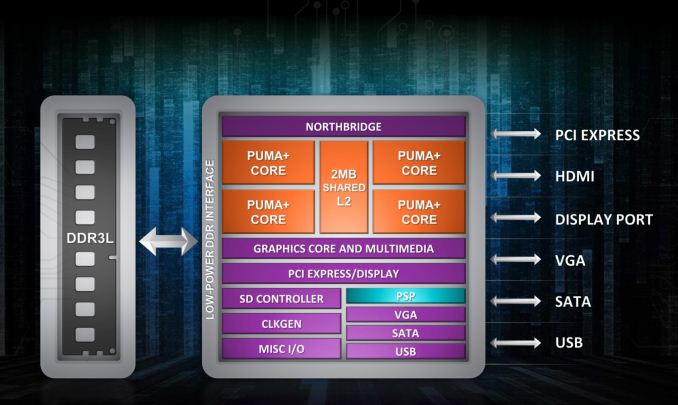AMD Beema/Mullins Architecture & Performance Preview
by Anand Lal Shimpi on April 29, 2014 12:00 AM ESTFinal Words
Despite no significant changes to the architecture or manufacturing process, AMD’s 2014 updates to its entry level and low power silicon are substantial. We finally have AMD silicon, built around a non-Bulldozer architecture, that seem to have turbo capabilities comparable to Intel’s. The result is a completely different performance profile. While AMD’s Jaguar cores in Kabini and Temash were easily outperformed by Intel’s Bay Trail, Puma+ pulls ahead. AMD continues to hold a substantial GPU performance advantage as well.
The gains in performance come while decreasing platform power. You can now have roughly the same performance as AMD offered last year in a 15W entry level notebook part, in a 4.5W TDP (2.8W SDP) tablet SKU. That’s seriously impressive.
The progress AMD made in a year with Beema and Mullins shows just how time constrained the team(s) were with bringing Kabini and Temash to market in 2013. While both of those SoCs were quite successful for AMD, I expect that at some point AMD won’t be allowed two years to fully polish a single design.
The big unknown is how these new SoCs stack up against Bay Trail when it comes to power consumption. From a performance standpoint at the very high end they are faster, but we’ll have to wait until we can get our hands on shipping devices before we know the full story when it comes to battery life. AMD expects to see Beema and Mullins designs show up over the next 1 - 2 quarters, with some designs shipping in the coming weeks to specific regions.
The other thing we need to see is a real Android strategy from AMD. Mullins seems like a good fit for a high performance Android tablet, but today AMD’s native OS strategy is exclusively Windows. I don’t think it’ll stay that way for long, but AMD has yet to give us any indication of when it’ll change.
And if I’m asking for things I want to see from AMD, you can add a PoP package and idle power that’s competitive with the likes of Apple and Qualcomm. AMD clearly came a long way over the past couple of years, but there’s still more progress to be made.











82 Comments
View All Comments
H2323 - Tuesday, April 29, 2014 - link
I think that is already a reality, Lenovo will be going with beema and kaveri for a variety of laptops, same with dell, AMD needs some HP wins thoughartk2219 - Thursday, May 1, 2014 - link
Thats interesting, normally I see that AMD has chips in lots of HP products but very rarely in any Dell products.ecmtb - Thursday, May 8, 2014 - link
According to this, Dell is planning on putting out a laptop with these new parts:http://www.cpu-world.com/news_2014/2014041801_AMD_...
formulav8 - Tuesday, April 29, 2014 - link
This sentence doesn't quite sound correct."The result is a memory interface that shaves off move than 500mW when run in this more strict, low power mode."
Move and Run mess it up. :)
HalloweenJack - Tuesday, April 29, 2014 - link
oh look the intel fangirls have arrived - a 4.5w part is matching a 10w intel part and they cry `its crap`...MrSpadge - Tuesday, April 29, 2014 - link
Seems more like the Intel hooligans ;)Kjella - Tuesday, April 29, 2014 - link
Yeah, power consumption has been AMDs Achilles heel for some time now both on the high end for performance and on the low end for battery life. And suddenly they can put the performance of a 15W Kabini in a 4.5W Mullins? If this holds up when it's actually released and reviewers can run real tests on it - battery tests would be extremely interesting - it could be a real winner. Assuming that people want x86 tablets though, I think the jury is still out on that.zodiacsoulmate - Tuesday, April 29, 2014 - link
How could this compete with Atom?????Atom have way lower TDP SDP or whatever power consumption they call it...
Atom have no problem surpassing the performance of this thing...
Price maybe AMD's advantage, but low power devices are still filled with high profit devices, also it's TDP may cause bad battery life, with may not be taht cost efficient afterall...
So why AMD still trying to compete here??
H2323 - Tuesday, April 29, 2014 - link
It wrecks anything silvermont based in benchmarks, Thing is mullins will not make a lot of gains in tablets, no android support and free intel chips, Beema will make some gains on baytrail until christmas.rocketbuddha - Tuesday, April 29, 2014 - link
Hi Anand,Can you confirm if Beema & Mullins are made at TSMC 28nm HKMG? Hardware France seems to think it is Global Foundries.
Thx